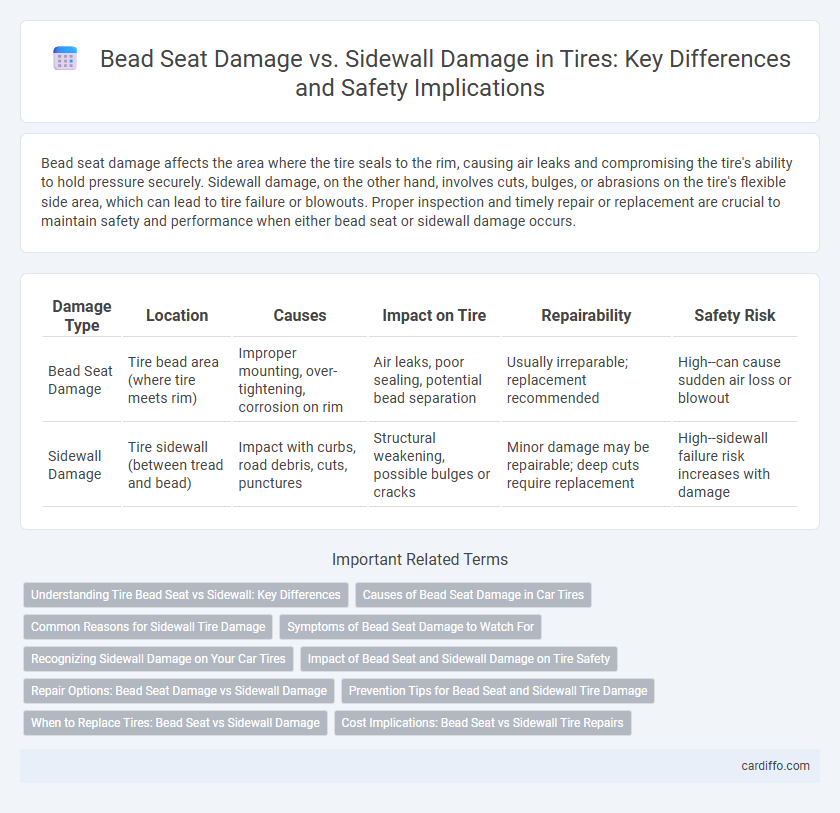Bead seat damage affects the area where the tire seals to the rim, causing air leaks and compromising the tire's ability to hold pressure securely. Sidewall damage, on the other hand, involves cuts, bulges, or abrasions on the tire's flexible side area, which can lead to tire failure or blowouts. Proper inspection and timely repair or replacement are crucial to maintain safety and performance when either bead seat or sidewall damage occurs.
Table of Comparison
| Damage Type | Location | Causes | Impact on Tire | Repairability | Safety Risk |
|---|---|---|---|---|---|
| Bead Seat Damage | Tire bead area (where tire meets rim) | Improper mounting, over-tightening, corrosion on rim | Air leaks, poor sealing, potential bead separation | Usually irreparable; replacement recommended | High--can cause sudden air loss or blowout |
| Sidewall Damage | Tire sidewall (between tread and bead) | Impact with curbs, road debris, cuts, punctures | Structural weakening, possible bulges or cracks | Minor damage may be repairable; deep cuts require replacement | High--sidewall failure risk increases with damage |
Understanding Tire Bead Seat vs Sidewall: Key Differences
Tire bead seat damage occurs where the tire meets the rim, compromising the airtight seal and causing potential air leaks or mounting difficulties. In contrast, sidewall damage affects the flexible part of the tire between the bead and tread, often leading to structural weakness and increased risk of blowouts. Understanding these key differences helps in accurate diagnosis and deciding whether tire repair or replacement is necessary for safety and performance.
Causes of Bead Seat Damage in Car Tires
Bead seat damage in car tires primarily occurs from improper mounting or dismounting techniques, leading to deformation of the bead area where the tire seals against the rim. Corrosion or debris on the wheel rim can prevent an airtight seal, causing bead separation and potential damage. Excessive impacts, such as hitting potholes or curbs, also contribute to bead seat damage by compromising the tire's structural integrity at the bead.
Common Reasons for Sidewall Tire Damage
Sidewall tire damage commonly occurs due to impacts with curbs, potholes, or road debris, causing cuts, bulges, or abrasions that compromise tire integrity. Unlike bead seat damage, which affects the tire's seal with the rim, sidewall damage directly weakens the tire's structural support and flexibility. Prolonged exposure to harsh environmental conditions and improper tire inflation also increase the risk of sidewall deterioration and failure.
Symptoms of Bead Seat Damage to Watch For
Symptoms of bead seat damage include difficulty maintaining proper tire pressure, visible cracks or separations around the tire bead area, and uneven tire mounting on the rim. Drivers may experience slow air leaks, unusual vibrations, or a noticeable loss of tire stability during turns. Monitoring these signs helps prevent further damage and ensures safe vehicle performance.
Recognizing Sidewall Damage on Your Car Tires
Recognizing sidewall damage on your car tires is crucial for vehicle safety because the sidewall is thinner and more vulnerable than the bead seat area. Common signs include visible cuts, bulges, or cracks that compromise the tire's structural integrity and can lead to blowouts. Unlike bead seat damage, which affects the tire's seal with the rim, sidewall damage directly weakens the tire's load-bearing capacity and requires immediate inspection or replacement.
Impact of Bead Seat and Sidewall Damage on Tire Safety
Bead seat damage compromises the tire's ability to maintain a proper seal with the rim, leading to air leakage and increased risk of sudden deflation, directly threatening tire safety. Sidewall damage weakens the tire's structural integrity, making it prone to blowouts under stress or high-speed conditions. Both types of damage significantly reduce overall tire safety by increasing the likelihood of failure, but bead seat damage often results in immediate air loss, while sidewall damage may cause delayed but catastrophic failure.
Repair Options: Bead Seat Damage vs Sidewall Damage
Bead seat damage typically requires professional tire servicing or replacement because it compromises the tire's ability to maintain an airtight seal with the rim, while sidewall damage often presents limited repair options due to structural weakness and safety concerns. Repairing sidewall damage is generally unsafe and discouraged, as patches or plugs cannot restore the tire's sidewall integrity, increasing the risk of blowouts. In contrast, bead seat damage can sometimes be addressed by reseating the tire or replacing the valve components, but tire replacement remains the most reliable solution for extensive damage in either area.
Prevention Tips for Bead Seat and Sidewall Tire Damage
Maintaining correct tire pressure and avoiding overloading significantly reduce the risk of bead seat and sidewall damage, ensuring proper tire bead seating and sidewall integrity during operation. Regular tire inspections for cuts, bulges, or cracks help identify early signs of sidewall damage, allowing timely intervention before further deterioration occurs. Proper mounting techniques and using manufacturer-recommended equipment prevent bead seat damage while maintaining tire aeration and safe handling.
When to Replace Tires: Bead Seat vs Sidewall Damage
Bead seat damage compromises the tire's ability to seal properly against the rim, often causing air leaks and necessitating immediate replacement to maintain safety. Sidewall damage, which includes cuts, bulges, or cracks, weakens the tire's structural integrity and increases the risk of blowouts, requiring tire replacement upon detection. Always replace tires if either bead seat or sidewall damage is evident to ensure optimal performance and prevent accidents.
Cost Implications: Bead Seat vs Sidewall Tire Repairs
Bead seat damage in tires often requires specialized repair techniques or complete tire replacement, leading to higher costs compared to sidewall damage, which can sometimes be patched if the damage is minor. Sidewall repairs, however, are usually limited to surface punctures or cuts and have a higher risk of failure, potentially resulting in additional expenses if the tire needs replacement later. Overall, bead seat damage typically results in more significant cost implications due to the complexity and safety concerns involved in repairing this critical tire area.
Bead seat damage vs sidewall damage Infographic

 cardiffo.com
cardiffo.com